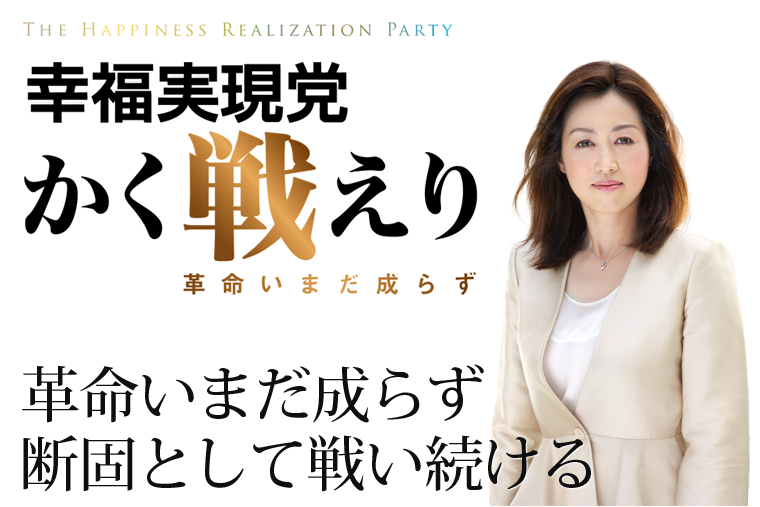Dubious Science
 Thursday, January 15, 2015 at 12:45PM
Thursday, January 15, 2015 at 12:45PM
 HRP's campaign poster for the 2014 general election features party president, Shaku Ryōko. The former party head used to be Ōkawa Kyōko, the wife of Happy Science founder Ōkawa Ryūhō. Seems they failed to realize their happiness together.
HRP's campaign poster for the 2014 general election features party president, Shaku Ryōko. The former party head used to be Ōkawa Kyōko, the wife of Happy Science founder Ōkawa Ryūhō. Seems they failed to realize their happiness together.
The first time I heard of Happy Science was during the 2009 Lower House election that would had the long-ruling Liberal Democratic Party (LDP) a well-deserved drubbing.
One day during the 12-day campaign period before the election,[1] a noisy political sound truck sped past me with the usual contingent of white gloved hands waving out of the windows and the improbable name Kōfuku Jitsugen Tō (幸福実現党, The Happiness Realization Party, HRP) plastered on the side of it.
“You gotta be kidding,” I said to myself as I waved back listlessly to the enthusiastic lackeys in the van.
In 2009, there was no shortage of minor political parties with silly names, including “The Essentials”, “The Freeway Club”, “Japan Smile Party” and “The Forest and Ocean Party”, none of which would gain any seats in the election. The Happies, however, would press on election after election.
Curiosity getting the better of me, I did a bit of research into the party when I got home that day and I learned that HRP was the political wing of Kōfuku no Kagaku (幸福の科学, Happy Science), a cult founded in 1986 by Ryūhō Ōkawa.
According to an article in The Japan Times, “the Happies have an eye-catching manifesto: multiply Japan’s population by 2 1/2 to 300 million and make it the world’s No. 1 economic power, and rapidly rearm for conflict with North Korea and China. If elected, the party’s lawmakers will invite millions of foreigners to work here, inject religion into all areas of life, and fight to overcome Japan’s ‘colonial’ mentality, which has ‘fettered’ the nation’s true claim to global leadership.”
I don’t know about you, but it sounded to me as if the person who wrote the manifesto had been smoking meth.
Pipe dream or not, Kōfuku Jitsugen Tō fielded 345 candidates, or nearly one in each electoral district—more than the either the Democratic Party of Japan, which would go on to win the election, or the ruling Liberal Democratic Party—in the 2009 election, yet failed to win any seats in the National Diet. Further bids in 2012 and 2014 with a similar number of candidates also yielded zero seats. At a cost of 3 million yen per individual electoral district and 6 million yen per proportional representation block, The Happies have squandered almost six billion yen (over $50 million) over the past three campaigns.
Or have they?
If the real aim of these hopeless election campaigns has been brand recognition rather than electoral victory, then The Happies must be very happy indeed. Six years ago, I had never heard of either the cult or its leader, but now I have. I’m sure it is no different with your average Tarō in Japan.
Still, fifty-plus million dollars ain’t chump change. By comparison, Mitt Romney spent $42 million of his own money in his failed attempt to win the Republican nomination for presidential candidate in 2007-08, the second most spent by a candidate self-financing his run. All of this got me thinking how The Happies were able to finance not only their election campaigns, but also their construction boom which has seen several gaudy new palaces dedicated to the ego of Ōkawa erected throughout Japan over the past several years.
It’s hardly news that religions, old and new, are able to generate fabulous amounts of tax-free income, but to make money, they’ve got to have adherents to their faith.
According to Happy Science’s, the cult claims to have twelve million followers in ninety countries. I found this number to be highly dubious as it is the exact same figure claimed by another cult, Sōka Gakkai. Although considered a “new religion” in Japan, S.G. International has been around since 1930 and has its origins in Nichiren Buddhism, which itself dates back to the 13th century. Although, I do not know anyone who is a follower of Ryūhō Ōkawa, I have come across quite a few members of Sōka Gakkai over the years. The entertainment world in Japan is famously peopled with followers of the religion.
By comparison, the Mormons[2] have over 15 million followers and the Jehovah’s Witnesses have 8.2 million, thanks to both religions’ aggressive missionary work throughout the world and unfortunately at my doorstep.
The more I ruminated on it, the more Happy Science’s claim of twelve million believers just didn’t add up.
Then it hit me. I knew how to get a fairly accurate estimate of Happy Science’s followers in Japan: the results of the 2009 election.
In the proportional representation blocks, The Happiness Realization Party and Kōmeitō, the party closely tied to Sōka Gakkai, got the following number of votes:
Hokkaidō Block
20,276 votes for HRP vs. 354,886 for Kōmeitō
Tōhoku Block
36,295 vs. 516,688
Northern Kantō Block
46,867 vs. 855,134
Southern Kantō Block
44,162 vs. 862,427
Tōkyō Block
35,667 vs. 717,199
Hokuriku Block
32,312 vs. 333,084
Tōkai Block
57,222 vs. 891,158
Kinki Block
80,529 vs 1,449,170
Chūgoku Block
32,319 vs. 555,552
Shikoku Block
19,507 vs. 293,204
Kyūshū Block
54,231 vs. 1,225,505
The Happiness Realization Party garnered about 459,000 proportional representational votes, less than 6% of the 8,054,000 votes for the Kōmeitō, which suggests that The Happies actually have around 720,000 followers. After watching this video of Ryūhō Ōkawa’s great psychic power, it makes me wonder how he managed to even get that many.
Obviously, I'm in the wrong business.
[1] For more on elections in Japan, go here.
[2] The Church of Jesus Christ of Latter-Day Saints
